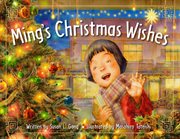Review by Booklist Review
Ming is an outsider wherever she goes. At school, she isn't allowed to sing in the Christmas choir because she's Chinese. At home, like other American children, she wants to put up a Christmas tree, but her fiercely Chinese mom angrily rejects the idea. Luckily, Dad is more understanding, and he takes Ming outside the city to visit some friends of her grandfather. The old men share stories of the past, and Ming learns more about her Chinese heritage. Later, in a grove of sequoias, Ming and her father pray at an altar built by Chinese miners and talk about her struggles. They ultimately find a tree that will appease both Ming and her mom: the Chinese pine, a symbol of long life. Tateishi's illustrations, oscillating between snowy winter and cozy indoor scenes, have lovely warmth, imparting a mythical quality to the tale. Ming's story shows that the search for one's place in the world begins young, and that, while there's pain in navigating two conflicting cultures, there's a way to heal.
From Booklist, Copyright (c) American Library Association. Used with permission.
Review by Publisher's Weekly Review
Inspired by family stories, Gong looks at Christmas through the eyes of Ming, the oldest child of immigrants in 1930s Northern California. Unwelcome in her school's Christmas choir, presumably because she's Chinese, Ming requests a Christmas tree at home, only to face Mama's disapproval because it's "not Chinese." Feeling unmoored, Ming ponders her place in the world. But a trip with her compassionate father into the snowy mountains--and a conversation with her grandfather's old friends--soon transforms Ming's perspective, as she learns about the significance of pine trees in her family's culture and encounters a generations-old altar left by Chinese miners, a powerful marker of immigrants' resilience in America. Gong's dialogue-heavy prose is lyrical and deeply sympathetic (about the mountain: "Here, he said, we are not foreigners. Here we are men, a small part of nature's greatness"). Intricate, warmly washed interiors and expansive landscapes by Tateishi enchant, conveying viewpoints from a variety of angles that effectively highlight Ming's varying emotions. A historical holiday story that poignantly explores identity and belonging from a less-seen perspective. Ages 5--6. (Sept.)
(c) Copyright PWxyz, LLC. All rights reserved
Review by Kirkus Book Review
Ming wants a Christmas tree, but her mother refuses, telling her, "Christmas trees are not Chinese." Accompanied by golden- and sepia-toned depictions of early-20th-century life, Gong's text gives readers a glimpse into the lives of families who arrived in the United States during the gold rush. Little Ming feels like an outsider, ostracized at school for being Chinese yet wanting to take part in American traditions. Why does Mama so vehemently refuse to participate? Then Pop takes her to visit some old friends of his father's, and she listens to them tell stories about panning for gold, traveling the West, and surviving the San Francisco earthquake, always recovering from setbacks with resilience and strength. Afterward, Ming and Pop visit a sequoia grove where many immigrants before them escaped their troubles and connected with nature. Pop also has a compromise for Ming and her mother, a new Christmas tradition that does not forsake Mama's Chinese roots. Most illustrations depict beautiful landscapes and settings illustrated with intricate details and glowing warmth, but human figures are inconsistent, the faces at times either too bland or a bit frightening. And while the plot is simple and Mama's motivations are unclear, it is Gong's depiction of the long arc of a bittersweet history in the context of the strength of human character that readers will remember. A thoughtful take on Chinese American history that goes beyond the usual fare. (Picture book. 4-8) Copyright (c) Kirkus Reviews, used with permission.
Copyright (c) Kirkus Reviews, used with permission.

